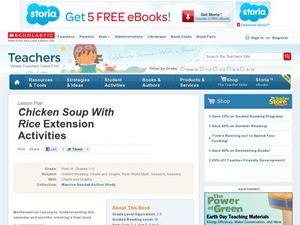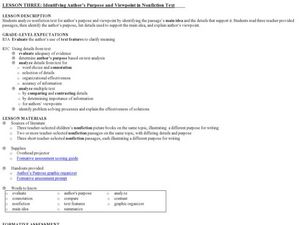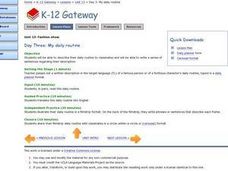Curated OER
Splat! Boom! Pow! the Influence of Cartoons in Contemporary Art
Students relate abstract expressionism and cultural influences on 1960's art. They use images appropriated from comic books to create a painting in the abstract expressionist style by changing the scale of the comic and reducing content...
Curated OER
On The Day You Were Born
Students engage in a study about the holiday of a birthday with the help of using children's literature. They make cognitive connections of using the characters of the book and relating them to the personal celebration of a birthday.
Curated OER
Lesson 1 Activity 2: A Place in Time
Students select place to study, note how it has changed over time, and create and illustrate a timeline.
Curated OER
Turtle Legends
Students listen to the legend, Thirteen Moons on Turtle's Back. They create a new moon for the calendar based on this natural part of everyday life in the seasons. They illustrate it under the story using water color paints.
Curated OER
Crazy Laws: There Must Have Been a Good Reason?
Students study the reasons for the passage of some "crazy" laws and illustrate one of them. They examine how current laws may seem outdated in 50 years.
Curated OER
When the Fly Flew In by Lisa Westberg Peters
The students will listen to the story When the Fly Flew In, and be able to identify the main idea of the story and many of the (supporting) details. Students will also develop an appreciation for the humor and illustrations. After...
Curated OER
Her stories: African American folktales, fairy tales, and true tales
Students discuss the illustration's allusion to the myth, Pandora's Box. Students locate instances of folk sayings or expressions that make these tales seem authentic to the reader. Students draw a Venn diagram comparing Catskinella and...
Curated OER
Long Vowel Sound-oo
Kindergarteners and first graders alike identify the word that matches the first two illustrations. Then they use two clues to illustrate the mystery word! Did they guess it correctly? Can they identify the oo?
Curated OER
Chicken Soup with Rice Extension Activities
After reading Chicken Soup with Rice, by Maurice Sendak, incorporate some of these great extension activities into your lesson plan. Ideas include focusing on knowing the months of the year, or studying the illustrations and how...
Curated OER
K-W-L Chart
After choosing a topic of interest, young learners use the K-W-L thinking process to create an informational, illustrated, big book. K-W-L, a three-part thinking process, asks the learner to respond to three questions: What do we know...
Curated OER
Creating and Presenting Haiku With Kid Pix
Students research the history and characteristics of haiku poetry using books and the Internet. They use Kid Pix to create and present original haiku.
Curated OER
100th Day Celebration
Pupils celebrate the 100th day of school with a variety of math and language arts activities based on the number 100. They make books, count objects, and draw their predictions about life 100 years from now. They also estimate the...
Curated OER
Dish: From A to Z
Students are read several ABC books and choose a different letter to illustrate for a class book. They use clip art to find his/her letter and insert it at the top of the page centered and find 4 pictures that begin with the same letter.
Curated OER
Angry Words: What Goes Around Comes Around
Students examine how angry words can effect the people and environment around them and identify ways to cope with angry feelings. They listen to the book Andrew's Angry Words by Dorothea Lachner, and participate in a simulation of how...
Curated OER
Career Education for Early Elementary Grades
It's never too early to connect children with the real world meaning of their work. A series of four one-hour sessions, plus a field trip, make up this unit on college and career readiness for first and second graders. After viewing a...
Curated OER
Berlioz the Bear
Young children read the story, Berlioz the Bear and complete various reading and writing activities. They learn about fiction and non-fiction, and complete graphing and writing activities for the story. Youngsters draw the bear and use...
Curated OER
Identifying Author’s Purpose and Viewpoint in Nonfiction Text
Why do people write books? Pupils discover how to identify the author's viewpoint. They read non-fiction passages their instructor selects (the plan has the class look at nonfiction children's picture books), and then identify the...
Curated OER
The Outsiders: Directed Reading Thinking Activity
It can be difficult to begin a novel when you don't know what it's about. Take the opportunity to begin S.E. Hinton's The Outsiders slowly, making predictions and answering questions about the book's first nine pages.
Curated OER
If I Were A Statue
Students locate and identify statues in their local community. They write what they would see or hear and how they would feel if they were statues. They illustrate their stories.
Curated OER
Henry Howls
Let's learn the letter h! Elementary learners will hear the sound, learn a catchy tongue twister, and identify the sound in different words the teacher says. After some writing practice, read A House for Hermit Crab, by Eric Carle,...
Curated OER
The Hat
Honing reading and communication skills through the theme of farm animals is the focus of this activity. Students read a book about Scandinavian farm animals and complete prediction journal activities. They complete a worksheet about the...
Curated OER
My Daily Routine
Foreign language learners work in pairs to translate the daily routine of celebrities or everyday people, presented in daily planner format, into English. They then illustrate and record their own daily routines in storyboard (film...
Curated OER
It's Raining Cats and Dogs
Make a beeline to this activity. Prepare paper strips with the provided idioms to engage teams in illustrating their literal meanings. The drawings provide the impetus for a guessing game where class members compete to be the first to...
Curated OER
MACBETH and the Themes of Ambition,
Students describe and compare characters and situations in dramas from and about cultures and historical periods, illustrate in improvised or scripted scenes, and discuss how theater reflects a culture.

























